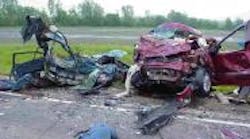“Drivers and other road users must take an active role in safety—their own and that of those sharing the road. Vehicle occupants need to buckle up and keep focused on the task of driving. Technologies may be able to detect the presence of vulnerable road users, but both they and the vehicle drivers need to be on the lookout for each other.” –David Strickland, chief administrator for the National Highway Traffic Safety Administration, speaking at the JASIC Government-Industry Seminar on Vehicle Safety in Tokyo this past May.
Our highways are safer than they’ve ever been, yet they remain extremely deadly – that’s the tragic contradiction current and future transportation strategy must continue to struggle with.
On the one hand, highway fatalities are down to their lowest level since 1954. Last year, 33,963 people died on U.S. highways – a drop of 8.9% when compared to the 37,261 deaths reported in 2008. Even more striking, the fatality rate for 2009 declined to the lowest ever recorded: 1.16 fatalities per 100 million vehicle miles traveled (VMT), down from 1.25 fatalities per 100 million VMT in 2008.
Yet the numbers are still horrifying: nearly 34,000 dead in a year; roughly 2,803 per month; a little over 93 a day; almost four dead per HOUR.
The Daily Beast website did some number crunching using National Highway Traffic Safety Administration (NHTSA) data (though for some reason it dropped the word ‘Traffic’ out of the agency’s name) to come up with a Top 100 list of the deadliest highways in America.
The publication analyzed five years of NHTSA accident data from nearly 250 stretches of interstate highways to find out which roads are the deadliest, mile for asphalt and concrete mile. Here are the top five (ones hard for truckers to avoid, I might add):
I-95 in Florida
I-76 in New Jersey
I-4 in Florida
I-15 in California
I-10 in California
Now, of course, all sorts of vehicle technologies and strategies are being deployed to try and bring these fatality numbers down – forward collision warning systems, land departure warning technology, engine speed governors, side airbags, and public service campaigns to focus on changing behaviors, such as talking on the cell phone while driving, etc.
Yet the biggest highway life saving effort remains the simplest and cheapest: buckling one’s seat belt.
[Here are some tips on how to properly wear your seat belt, courtesy of Ford Motor Co.]
According to U.S. Department of Transportation (DOT) figures, seat belt use is at a record high of 84%. Yet that figure means 45 million Americans do NOT “buckle up” when either driving or riding in motor vehicles.
In trucking, seat belt use is lower than the national average but rising quickly. The Federal Motor Carrier Safety Administration (FMCSA) reported earlier this year that overall safety belt use by commercial drivers climbed to 74% in 2009 from 65% in 2007.
More importantly, according to Steve Keppler, interim executive director for the Commerical Vehicle Safety Alliance (CVSA) is that overall seat belt use among commercial drivers of all types has jumped dramatically in a very short time – from 48% in 2004 and 2005 to over 74% as of last year.
“This is significant because, if you look at truck driver fatalities in highway crashes, a large portion of them weren’t wearing their seat belts,” he explained. “That seat belt usage rate not only directly impacts the number of lives saved on the highways, it also gives drivers a better opportunity to stay in control of the vehicle and perhaps reduce the severity of a crash – though that benefit is very difficult to quantify.”
Yeah, yeah, you’ve heard it all before. But ponder this factoid: According to NHTSA, on any given day, about 38 people who are not buckled-up get killed in motor vehicle crashes. That’s over ONE THIRD of daily highway fatalities in the U.S. In 2008 alone, nearly 14,000 unbuckled passenger vehicle occupants lost their lives on U.S. roadways, NHTSA added, and it estimates nearly half of them could have been saved if they had been belted.
NHTSA statistics also show that those least likely to buckle-up are: teenagers; young adults; males; night time riders; motorists traveling on rural roads; and individuals traveling in pick-up trucks.
“Regular seat belt use is the single best way to protect yourself and your family in motor vehicle crashes,” emphasized NHTSA Administrator David Strickland. “Wearing your seat belt costs you nothing. But the cost for not wearing one certainly will. Buckle up day and night – every trip, every time.”
Good advice if you ask me.






